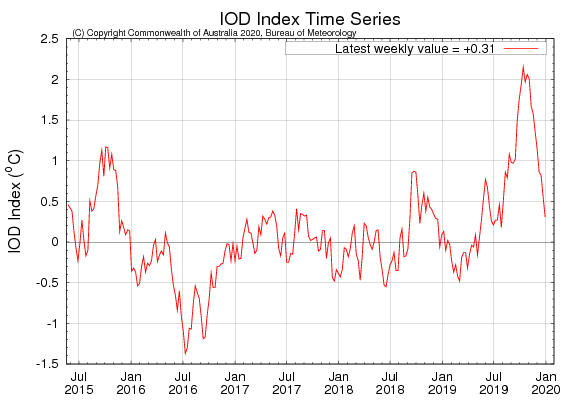The positive Indian Ocean Dipole that has underpinned one of Australia's warmest and driest years on record has finally broken down.
The Indian Ocean Dipole refers to an index that measures sea surface temperatures in the tropical Indian Ocean. When the index is positive, the pattern of sea surface temperatures across the Indian Ocean restricts the amount of moisture in the atmosphere over Australia. This typically causes below average rain and above average temperatures in large parts of the country.
The Indian Ocean Dipole adopted a positive pattern in late May and persisted in this phase until late December, reaching a strong peak in October.
Image: Indian Ocean Dipole index showing a prolonged positive phase between May and December in 2019. Source: Bureau of Meteorology.
This prolonged and strongly positive Indian Ocean Dipole helped cause unusually warm and dry weather in Australia between winter and early summer, exacerbating the drought and helping bushfires burn across eastern Australia.
While Indian Ocean Dipole events usually dissipate in late spring, the strength of this episode allowed it to persist well into summer. However, the latest weekly index value has dropped to neutral territory for the first time in months.
While this doesn't mean the weather in Australia will change abruptly, it does take this dominant climate driver out of the equation as we head into the new year.
The IOD phenomenon was first identified by climate researchers in 1999. ... In 2008, Nerilie Abram used coral records from the eastern and western Indian Ocean to construct a coral Dipole Mode Index extending back to 1846 AD.
- Forums
- Political Debate
- Indian Ocean Dipole (IOD) breaks down
Indian Ocean Dipole (IOD) breaks down
-
- There are more pages in this discussion • 42 more messages in this thread...
You’re viewing a single post only. To view the entire thread just sign in or Join Now (FREE)






